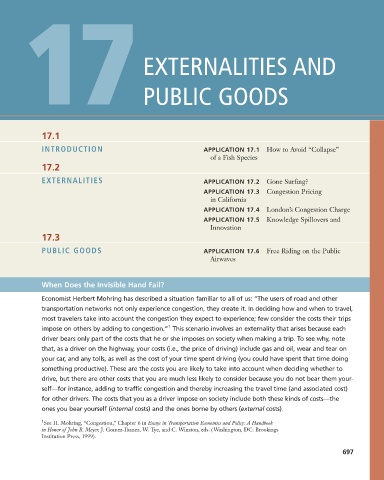Page 723 - Microeconomics, Fourth Edition
P. 723
c17ExternalitiesandPublicGoods.qxd 8/22/10 4:56 AM Page 697
17 EXTERNALITIES AND
17.1 PUBLIC GOODS
INTRODUCTION APPLICATION 17.1 How to Avoid “Collapse”
of a Fish Species
17.2
EXTERNALITIES APPLICATION 17.2 Gone Surfing?
APPLICATION 17.3 Congestion Pricing
in California
APPLICATION 17.4 London’s Congestion Charge
APPLICATION 17.5 Knowledge Spillovers and
Innovation
17.3
PUBLIC GOODS APPLICATION 17.6 Free Riding on the Public
Airwaves
When Does the Invisible Hand Fail?
Economist Herbert Mohring has described a situation familiar to all of us: “The users of road and other
transportation networks not only experience congestion, they create it. In deciding how and when to travel,
most travelers take into account the congestion they expect to experience; few consider the costs their trips
1
impose on others by adding to congestion.” This scenario involves an externality that arises because each
driver bears only part of the costs that he or she imposes on society when making a trip. To see why, note
that, as a driver on the highway, your costs (i.e., the price of driving) include gas and oil, wear and tear on
your car, and any tolls, as well as the cost of your time spent driving (you could have spent that time doing
something productive). These are the costs you are likely to take into account when deciding whether to
drive, but there are other costs that you are much less likely to consider because you do not bear them your-
self—for instance, adding to traffic congestion and thereby increasing the travel time (and associated cost)
for other drivers. The costs that you as a driver impose on society include both these kinds of costs—the
ones you bear yourself (internal costs) and the ones borne by others (external costs).
1 See H. Mohring, “Congestion,” Chapter 6 in Essays in Transportation Economics and Policy: A Handbook
in Honor of John R. Meyer, J. Gomez-Ibanez, W. Tye, and C. Winston, eds. (Washington, DC: Brookings
Institution Press, 1999).
697

